India is truly a fascinating country, with a new culture in every step of the way. One such destination is tucked away in the eastern edge of the sub-
India is truly a fascinating country, with a new culture in every step of the way. One such destination is tucked away in the eastern edge of the sub-continent, West Bengal. West Bengal is one of the most colourful and culturally rich states in India. Renowned all over the world for its delicious food, melodic music and vibrant festivals, it is not only culturally active but it is also a sight for sore eyes. The folk dance of West Bengal is highly expressive, colourful and involves a lot of elegant movements. It is a very beautiful way of storytelling that one should experience at least once. The dances are ingrained in the people of West Bengal which beautifully reflects the faith and traditions of the people of Bengal. The dances of West Bengal will definitely cheer you up and leave you with a positive vibe.
Here are the different types of folk dances of West Bengal:
1. Purulia Chhau Dance
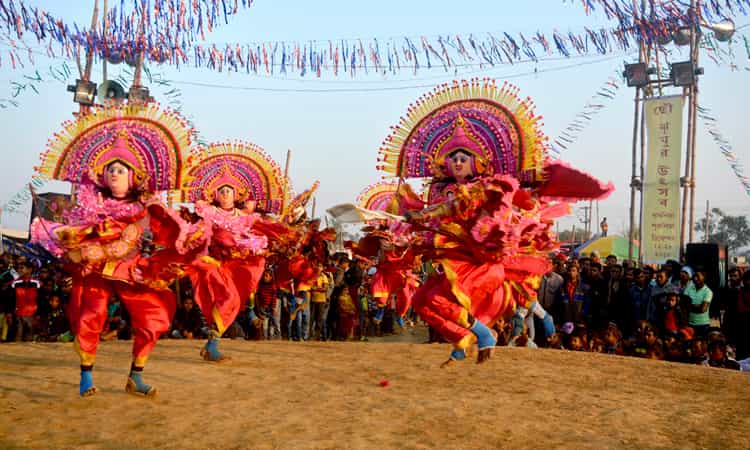
The Chhau dance of Bengal is one of the most colourful vibrant art forms. The roots of this dance can be traced to the martial practice as it is one of the most vigorous styles of performances. The main concept of this dance depicts the story of 2 great Indian epics of Mahabharat and Ramayan. The dancers dawn themselves completely in the character by wearing elaborate masks, headgears, colourful ornaments as well as apparels. Being centuries old, this dance form has been ever since been preserved by the people of Mahato, Kurmi, Bhumija, Dom, Deowa and Bhauma community. The dance is performed accompanied with musical instruments such as Dhol, Shehnai and Dhamsa.
2. Baul Dance
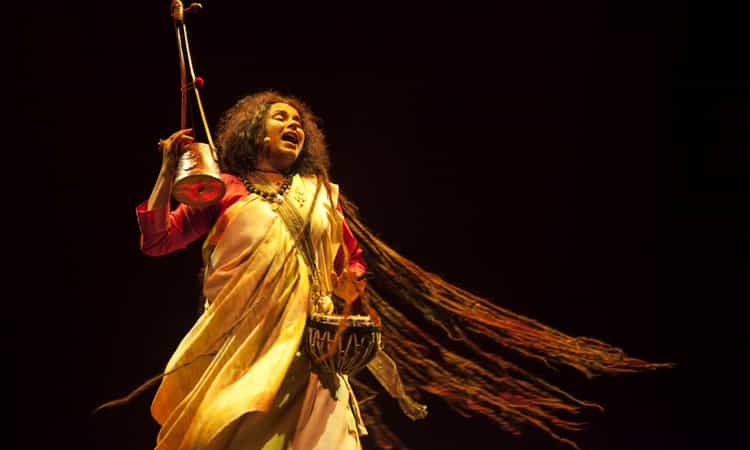
Baul dance forms a connection between love and spirituality. It is a rather mesmerising song and dance performance that aims at establishing a connection between the almighty that resides in the souls of humans. The history of Baul Dance can be dated back to the 15th century or the time of Srikrishna Kirtan. Through their ethereal and philanthropic dance style, Baul is also believed to have impacted the freedom movement and in 2005 Bauls was also declared as ‘the masterpieces of the oral and intangible heritage of humanity by UNESCO’. The Baul dancers wear a saffron cloak or Alkhalla and carry the one stringed instrument called ektara. They also tie small bells on their feet that keep ringing throughout the performance.
3. Santhali Dance
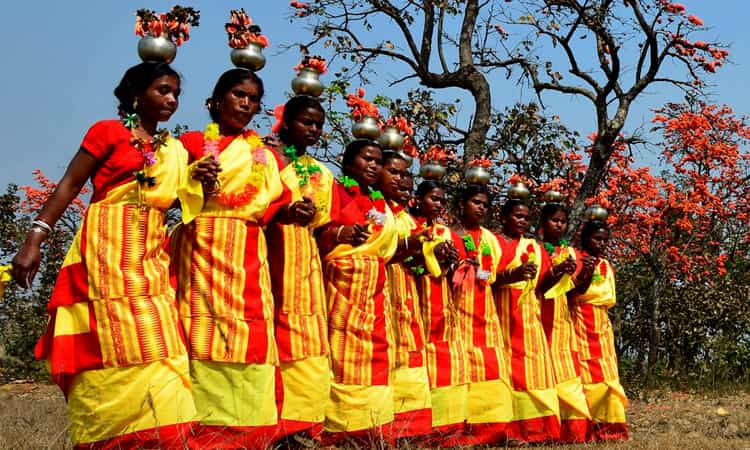
The name of this dance form is derived from the Santhal community who form an integral part of the folklore of Bengal. This dance form can be seen in districts of Malda, Birbhum, Bankura and Barddhaman. The santhals are considered to be born dancers as this dance forms a major part of all festivities and celebrations in the santhals community. One of the most mesmerizing and notable features of Santhali dance is the fact that it is done in perfect unison. Performed traditionally against the background music of instruments like flute, Jhanjh, Madol, Dhamsa and sometimes even Shehnai. The simplicity of theme and language is what makes this dance incredibly endearing.
4. Gambhira Dance
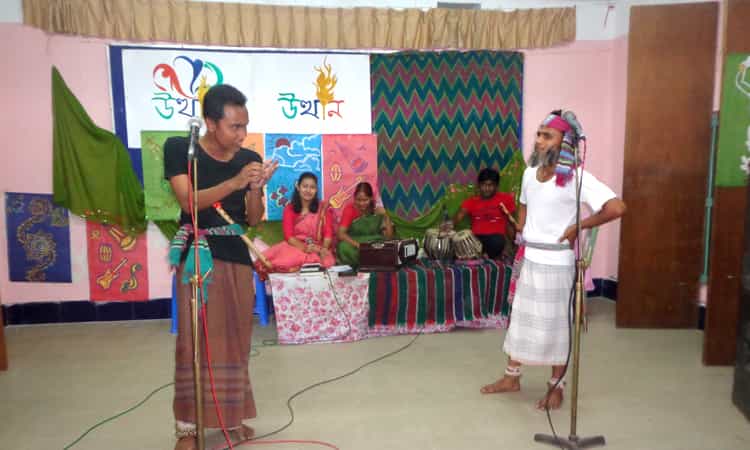
The word Gambhira translates into a ‘Devalaya’ or ‘the house of god’ and is one of the most popular dance forms of Malda district. The song and dance is very closely related to the enigmatic combination of mythology and agriculture. The performances depict the various stages and aspects that the farming community of West Bengal goes through during the agricultural production stages. The background theme is based on mythological aspects. Depending on the theme of the occasion the performance is done either in couples, groups or solo form. The dance also represents the amalgamation of different religious schools of thought like Shaivism, Vaishnavism, Buddhism and Shaktism. The dancers tune in their steps with the music of the instruments like Dhak, Dhol and gong or Kanshi.
5. Mundari Dance
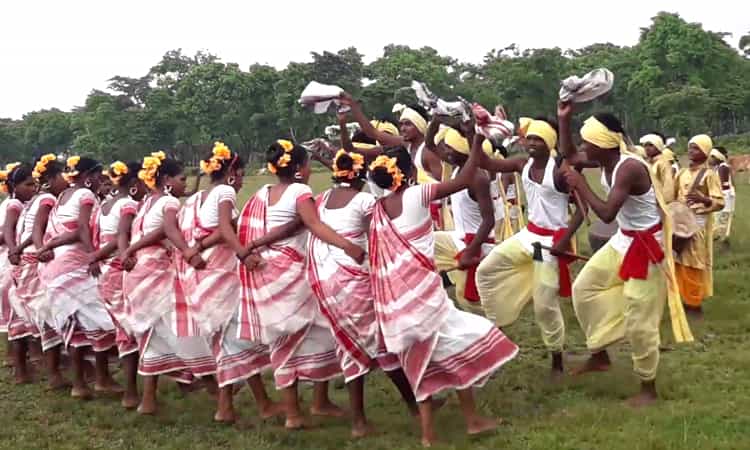
The name of this dance is derived from the people of the Mundari community residing in West Bengal. The people of this community come together to rhythmically do the dance during some special occasion or festival, most of which are related to agriculture. Other than West Bengal, it is one of the most important dance forms for the people of the Munda community in Jharkhand as well as the entire Chota Nagpur plateau. Although performed differently in different regions, the dance is women-centric, very graceful and performed in a smooth slow manner. The dancers form a circle and move slowly inwards with heads slightly bowed to the front.
6. Gajan Dance
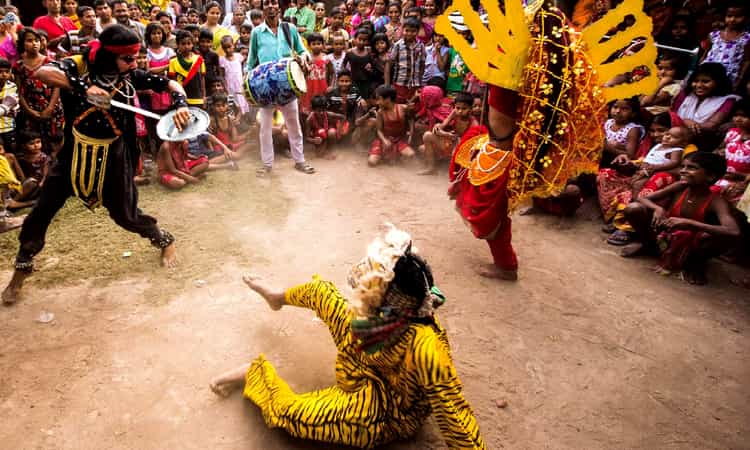
Named after one of the most famous popular festivals in some parts of Bengal, Gajan song and dances are performed to praise Lord Shiva and goddess Parvati during the holy Bengali month of Chaitra. The dance is performed with immense devotions and respect for the god and goddess. The dance performers dress up as the gods and goddess themselves and move in groups from one village to another dancing, singing and grooving to the music of Dhol, Kanshi and flute. Also known as Bolan in Murshidabad, the dancers first of all go through a rigorous stage of penance in order to attain salvation from the worldly sufferings. The puja rituals during the dance are done by people belonging to the lower caste while the involvement of the upper caste people is limited.
7. Durga Puja Dhunuchi
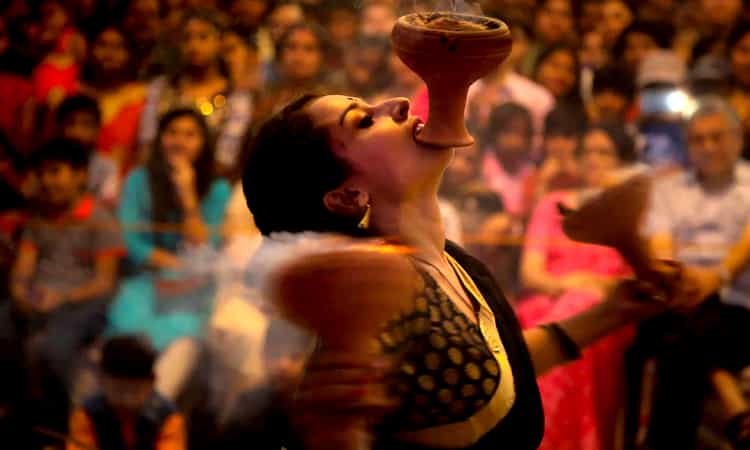
This is one of the most important festivals for the Bengali population and they wait throughout the year to celebrate this festival and the arrival of Durga Maa to their homes and lives. This dance is performed to appease Durga Mata and is done with great enthusiasm and perfect synchronisation to the sound of the Dhak instrument. According to tradition, this dance is performed on the Shashthi Tithi or the evening Aarti. You may have seen Durga Puja pictures where the dhunuchi performer balances an earthen bowl containing incense in their hands, forehead or mouth. It is a rather mesmerising sight to behold. The dance in fact derives its name from the earthen pots used in the performance that are locally called Dhunuchi.
8. Bratachari Dance
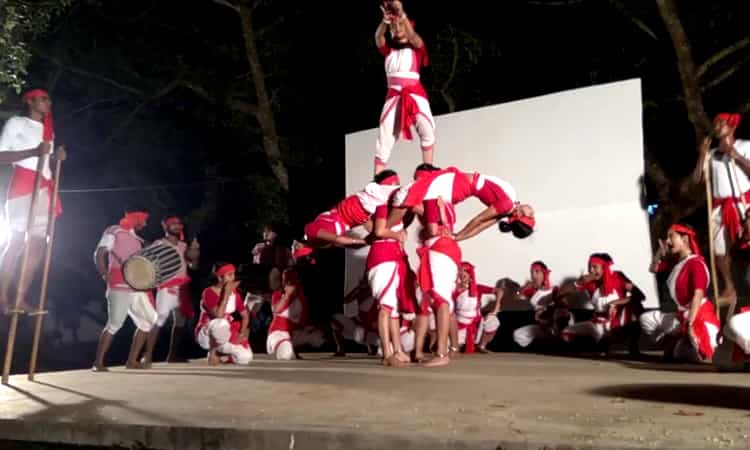
Bratachari dance is a male-centric dance and is an important part of the Bratachari tradition of West Bengal. The roots of Bratachari dance can be traced back to the ancient times in Bengal when they were known all over the world for their military prowess. The dance reminds you of the time when wars were prominent. Also known as Raibeshe dance, it belongs to a living tradition of the war dances of West Bengal. The term Rai refers to the royalty and Bansha means bamboo. The dance is rather entertaining to witness as it involves rigorous steps, acrobatic stunts and mock fighting. The dance represents the great valour of the bygone, fighter Bengalis.
9. Laghur Nritya Dance
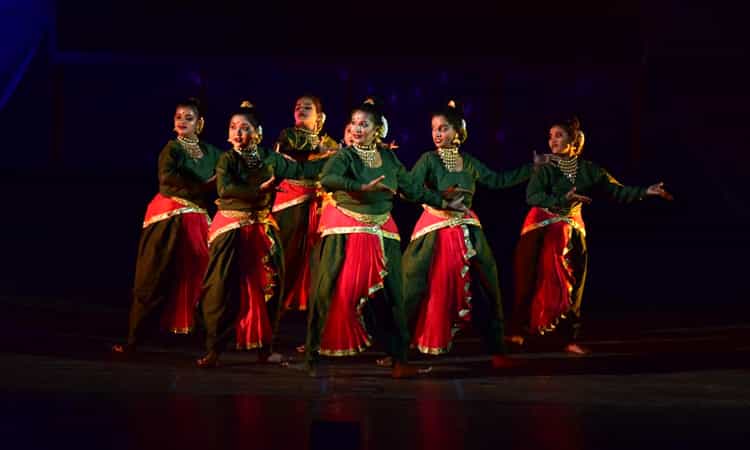
Laghur Nritya is another important and significant martial folk art form that is definitely a treat to watch. Also referred to as stick dance, this is another one of the most dramatic and artistic dance forms of West Bengal. Sticks are used in its performance representing self defence. A stick is used as it has been one of the most common forms of self defence weapons since time immemorial. The long sticks not only help in keeping up with the beats of the song but are also used to perform feats of acrobatic acts that keeps the audience entertained. These performances are used to showcase the various forms of self defence that the Bengalis have used since forever. It is an elaborate glimpse into the culture and traditions of the traditional Bengalis.
10. Dhali and Paika Nritya Dance
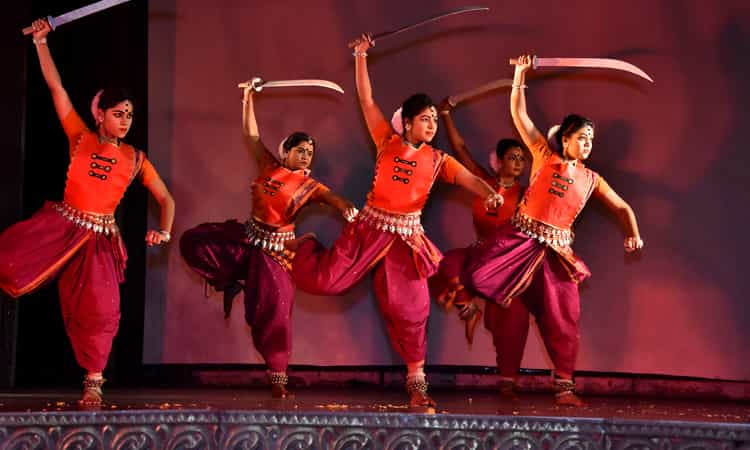
Dhali and Paika are two forms of heroic war dances and are performed by a large group of dancers. The dance is rather evocative and represents the prowess and unmatched valour of the people who partake in wars. The Dhali in this dance translates into a ‘shield’ which is often used for self defence during wars. This war dance dates back to the ancient ages and involves spectacular formal movements and falls more under the category of athletic exercises. Involving intricate manoeuvres and elaborate dance formations, Dhali and Paika Nritya is high in aesthetic value. Being a highly intense war dance, it is not accompanied with any music. What began as a manly dance, has now extended to women dancers as well.
11. Natua Dance
Natua dance is performed primarily by the people of the rabha community who reside in the northern end of West Bengal. Both men as well as women participate in the dance performance and have different roles. Where men play the various instruments that take the dance forward, women dance to the tune of the men playing various instruments like Barangshi, hem, Dandi and barding etc. most of the instruments may be unrecognisable to many as they are made out of natural materials and date back to the ancient ages. The dancers showcase the daily life of the community and embody the merriment. The dance is very unique as there are different dance forms dedicated to different occasions.
Frequently Asked Questions (FAQs)
Q. What Is Bengali Culture Known For?
Ans. Bengali culture is known for enlightenment and excellent taste in arts. Its culture consists of a pattern of belief, customs, human behaviour etc.
Q. What Is The Traditional Dress Of Bengali For Women?
Ans. Garad is the Traditional Saree that is worn by Bengali women that is white in colour and has a bright red border.
Q. When Is The Best Time To Visit West Bengal?
Ans. October to mid-April is the perfect time to visit West Bengal.
Q. What Is The Art Culture Of Bengal?
Ans. The Bengali art culture consists of embroidery, sculpture making, metal crafts and textile making.
Q. Which Is The Most Famous Festival Of West Bengal?
Ans. Durga puja is the most awaited and famous festivals of West Bengal.


COMMENTS